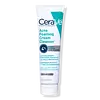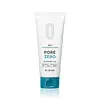What's inside
What's inside
 Key Ingredients
Key Ingredients

 Benefits
Benefits

 Concerns
Concerns

 Ingredients Side-by-side
Ingredients Side-by-side

Benzoyl Peroxide 4%
Water
Skin ConditioningGlycerin
HumectantPropylene Glycol
HumectantCocamidopropyl Hydroxysultaine
CleansingSodium C14-16 Olefin Sulfonate
CleansingXanthan Gum
EmulsifyingPotassium Hydroxide
BufferingCeramide NP
Skin ConditioningCeramide AP
Skin ConditioningCeramide EOP
Skin ConditioningCarbomer
Emulsion StabilisingNiacinamide
SmoothingGlycolic Acid
BufferingSodium Chloride
MaskingSodium Citrate
BufferingSodium Hyaluronate
HumectantSodium Lauroyl Lactylate
EmulsifyingSodium Hydroxide
BufferingCholesterol
EmollientPhenoxyethanol
PreservativePropanediol
SolventCitric Acid
BufferingTetrasodium EDTA
Diethylhexyl Sodium Sulfosuccinate
CleansingPhytosphingosine
Skin ConditioningEthylhexylglycerin
Skin ConditioningBenzoic Acid
MaskingBenzoyl Peroxide 4%, Water, Glycerin, Propylene Glycol, Cocamidopropyl Hydroxysultaine, Sodium C14-16 Olefin Sulfonate, Xanthan Gum, Potassium Hydroxide, Ceramide NP, Ceramide AP, Ceramide EOP, Carbomer, Niacinamide, Glycolic Acid, Sodium Chloride, Sodium Citrate, Sodium Hyaluronate, Sodium Lauroyl Lactylate, Sodium Hydroxide, Cholesterol, Phenoxyethanol, Propanediol, Citric Acid, Tetrasodium EDTA, Diethylhexyl Sodium Sulfosuccinate, Phytosphingosine, Ethylhexylglycerin, Benzoic Acid
Water
Skin ConditioningMyristic Acid
CleansingGlycerin
HumectantButylene Glycol
HumectantGlycol Distearate
EmollientPotassium Hydroxide
BufferingTea-Lauryl Sulfate
CleansingStearic Acid
CleansingLauryl Betaine
CleansingGlyceryl Stearate
EmollientPEG-100 Stearate
Lauric Acid
CleansingBeeswax
Emulsion StabilisingLauryl Glucoside
CleansingButyrospermum Parkii Butter
Skin ConditioningSalix Alba Bark Water
Astringent1,2-Hexanediol
Skin ConditioningCeteareth-60 Myristyl Glycol
EmulsifyingCaprylyl Glycol
EmollientPolyquaternium-7
Pentylene Glycol
Skin ConditioningPropanediol
SolventSalix Alba Bark Extract
AstringentSalicylic Acid
MaskingTromethamine
BufferingGlycolipids
Skin ConditioningHydroxyethylcellulose
Emulsion StabilisingMethylpropanediol
SolventPrunus Davidiana Extract
AntioxidantSalvia Hispanica Seed Extract
EmollientVitis Vinifera Fruit Extract
Skin ConditioningPyrus Malus Fruit Extract
Skin ConditioningPrunus Mume Fruit Extract
HumectantCarica Papaya Fruit Extract
Skin ConditioningSilkworm Cocoon Extract
HumectantSodium Bisulfite
AntioxidantDisodium EDTA
Sodium Benzoate
MaskingParfum
MaskingWater, Myristic Acid, Glycerin, Butylene Glycol, Glycol Distearate, Potassium Hydroxide, Tea-Lauryl Sulfate, Stearic Acid, Lauryl Betaine, Glyceryl Stearate, PEG-100 Stearate, Lauric Acid, Beeswax, Lauryl Glucoside, Butyrospermum Parkii Butter, Salix Alba Bark Water, 1,2-Hexanediol, Ceteareth-60 Myristyl Glycol, Caprylyl Glycol, Polyquaternium-7, Pentylene Glycol, Propanediol, Salix Alba Bark Extract, Salicylic Acid, Tromethamine, Glycolipids, Hydroxyethylcellulose, Methylpropanediol, Prunus Davidiana Extract, Salvia Hispanica Seed Extract, Vitis Vinifera Fruit Extract, Pyrus Malus Fruit Extract, Prunus Mume Fruit Extract, Carica Papaya Fruit Extract, Silkworm Cocoon Extract, Sodium Bisulfite, Disodium EDTA, Sodium Benzoate, Parfum
 Reviews
Reviews

Ingredients Explained
These ingredients are found in both products.
Ingredients higher up in an ingredient list are typically present in a larger amount.
Glycerin is already naturally found in your skin. It helps moisturize and protect your skin.
A study from 2016 found glycerin to be more effective as a humectant than AHAs and hyaluronic acid.
As a humectant, it helps the skin stay hydrated by pulling moisture to your skin. The low molecular weight of glycerin allows it to pull moisture into the deeper layers of your skin.
Hydrated skin improves your skin barrier; Your skin barrier helps protect against irritants and bacteria.
Glycerin has also been found to have antimicrobial and antiviral properties. Due to these properties, glycerin is often used in wound and burn treatments.
In cosmetics, glycerin is usually derived from plants such as soybean or palm. However, it can also be sourced from animals, such as tallow or animal fat.
This ingredient is organic, colorless, odorless, and non-toxic.
Glycerin is the name for this ingredient in American English. British English uses Glycerol/Glycerine.
Learn more about GlycerinPotassium hydroxide is commonly known as caustic potash. It is used to fix the pH of a product or as a cleaning agent in soap. In cleansers, it is used for the saponification of oils.
Sapnification is the process of creating fatty acid metal salts from triglycerides and a strong base. During this process, Potassium Hydroxide is used up and is not present in the final product.
Using high concentrations of Potassium Hydroxide have shown to irritate the skin.
Learn more about Potassium HydroxidePropanediol is an all-star ingredient. It softens, hydrates, and smooths the skin.
It’s often used to:
Propanediol is not likely to cause sensitivity and considered safe to use. It is derived from corn or petroleum with a clear color and no scent.
Learn more about PropanediolWater. It's the most common cosmetic ingredient of all. You'll usually see it at the top of ingredient lists, meaning that it makes up the largest part of the product.
So why is it so popular? Water most often acts as a solvent - this means that it helps dissolve other ingredients into the formulation.
You'll also recognize water as that liquid we all need to stay alive. If you see this, drink a glass of water. Stay hydrated!
Learn more about Water